-

人教版高中政治必修3世界文化的多样性教案
五、课后反思课后组织学生讨论对本课的感受,同学们都非常乐意采取这种上课方式,既可以通过资料的搜集、整理提高自身信息采集的能力,也能够提高自己学习积极性,变枯燥为生动。本人在教学中也深深地感到:一方面,充分发挥学生的主体作用,有利于启发同学的思维,培养自主思考的能力。而充分利用网络的教学功能,将现代信息技术和学科教学很好地结合了起来。只有调动全体同学的积极性、主动性、创造性,我们的教学才能有生命力;另一方面,光有学生的活动也不行,虽然学生能够积极投入地利用互联网搜集并动手制作课件,在课堂交流中能很好地进行发散思维和创造性思维,但其集中思维和抽象性思维还存在一定的缺陷,主要体现在对搜集的材料的取舍是以及对知识点的归纳和深化方面,所以在充分发挥学生的主体作用的同时应该也必须重视教师主导作用的发挥,引导学生由形象到抽象、由发散到集中、由演绎到归纳的思维能力的逐步提高。
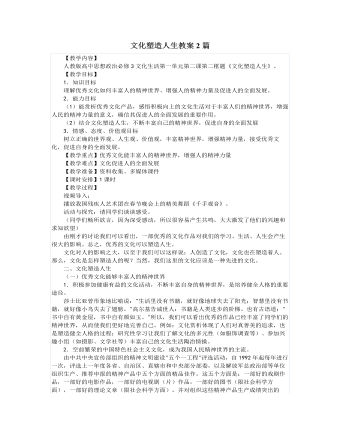
人教版高中政治必修3文化塑造人生教案2篇
【教学内容】人教版高中思想政治必修3文化生活第一单元第二课第二框题《文化塑造人生》。【教学目标】1.知识目标理解优秀文化如何丰富人的精神世界、增强人的精神力量及促进人的全面发展。2.能力目标(1)能赏析优秀文化产品,感悟积极向上的文化生活对于丰富人们的精神世界,增强人民的精神力量的意义,确信其促进人的全面发展的重要作用。(2)结合文化塑造人生,不断丰富自己的精神世界,促进自身的全面发展3.情感、态度、价值观目标树立正确的世界观、人生观、价值观,丰富精神世界,增强精神力量,接受优秀文化,促进自身的全面发展。【教学重点】优秀文化能丰富人的精神世界,增强人的精神力量【教学难点】文化促进人的全面发展【教学准备】资料收集、多媒体课件【课时安排】1课时【教学过程】视频导入:播放我国残疾人艺术团在春节晚会上的精美舞蹈《千手观音》。

人教版高中政治必修3文化与经济、政治教案
另一方面,文化素质影响公民政治权利的行使。随着民主和法制建设的发展,人们为了参与政治生活,需要更高的文化素养。文化水平提高了,人们受到的教育、接受的信息就越多,活动的领域就越广,民主法制和权利意识就越强,这些都会影响人们的民主素质和民主水平,使人们更好地进行政治参与,行使民主权利。(2)文化与国际政治相互交融,成为当代国际政治斗争的重要内容。随着世界多极化的发展,奉行霸权主义的国家,借助文化渗透的方式,竭力推销自己的价值观念,企图削弱和取代别国的民族文化,以推行强权政治。这使世界范围内反对文化霸权主义的斗争,成为当代国际政治斗争的重要内容。文化已经成为进行政治斗争、国际斗争的重要形式之一。对文化市场的争夺不仅仅是争夺票房价值、争夺经济效益,更主要的是对受众对象的争夺,对受众注意力这种特殊的稀缺资源的占有,以及在此基础上对舆论的控制与引导。因此,失去文化市场就意味着失去政治优势,意味着政治影响力的边缘化乃至萎缩或丧失。这一点,从目前世界正在进行的空前规模的“文化战争”,可以看得非常清楚。
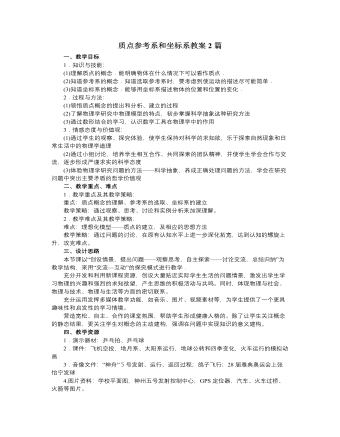
人教版新课标高中物理必修1质点参考系和坐标系教案2篇
①平动的物体一般可以看作质点做平动的物体,由于物体上各点的运动情况相同,可以用一个点代表整个物体的运动,在这种情况下,物体的大小、形状就无关紧要了,可以把整个物体当质点。例如:平直公路上行驶的汽车,车身上各部分的运动情况相同,当我们把汽车作为一个整体来研究它的运动的时候,就可以把汽车当作质点。当然,假如我们需要研究汽车轮胎的运动,由于轮胎上各部分运动情况不相同,那就不能把它看作质点了。要注意的是:同一物体在不同情况下有时可看质点,有时不可以看作质点,一列火车从北京开到上海,研究火车的运行的时间,可将火车看成质点,而火车过桥时,计算火车过桥的时间,不可以将火车看成质点。②有转动但转动为次要因素例如:研究地球公转时,可把地球看作质点;研究地球自转时,不能把地球看作质点。③物体的形状、大小可忽略再如:乒乓球旋转对球的运动的较大的影响,运动员在发球、击球时都要考虑,就不能把乒乓球简单看作质点。
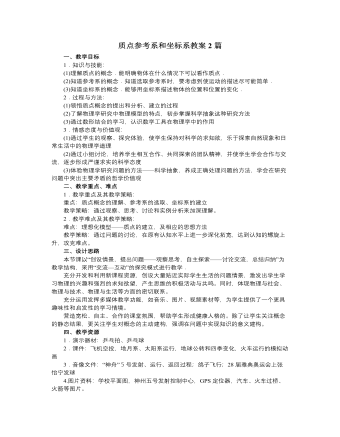
人教版新课标高中物理必修1质点参考系和坐标系教案2篇
(创设实例:多媒体播放视频刘翔的110m栏。)1.提出问题:怎样定量(准确)人描述车或刘翔所在的位置?2.提示:你的描述必须能反映物体(或人)的运动特点(直线)、运动方向、各点之间的距离等因素。3.总结:①为了定量地描述物体的位置及位置的变化,需要在参考系上建立适当的坐标系。坐标系是在参考系的基础上抽象出来的概念,是抽象化的参考系。为了定量地描述物体的位置及位置的变化需要在参考系上建立适当的坐标系,如果物体在一维空间运动,即沿一条直线运动,只需建立直线坐标系,就能准确表达物体的位置;如果物体在二维空间运动,即在同一平面运动,就需要建立平面直角坐标系来描述物体的位置;当物体在三维空间运动时,则需要建立三维坐标系。①一维坐标:描述物体在一条直线上运动,即物体做一维运动时,可以以这条直线为x轴,在直线上规定原点、正方向和单位长度,建立直线坐标系。如图1-1-1所示,若某一物体运动到A点,此时它的位置坐标XA=3m,若它运动到B点,则此时它的坐标XB=-2m(“-”表示沿X轴负方向)。
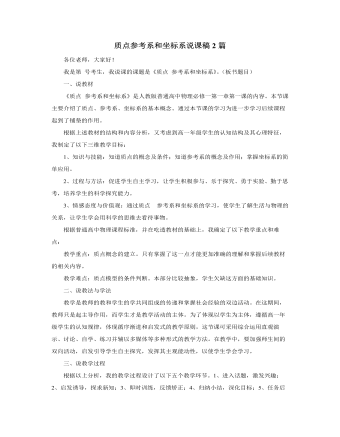
人教版新课标高中物理必修1质点参考系和坐标系说课稿2篇
一、说教材《质点 参考系和坐标系》是人教版普通高中物理必修一第一章第一课的内容。本节课主要介绍了质点、参考系、坐标系的基本概念。通过本节课的学习为进一步学习后续课程起到了铺垫的作用。根据上述教材的结构和内容分析,又考虑到高一年级学生的认知结构及其心理特征,我制定了以下三维教学目标:1、知识与技能:知道质点的概念及条件;知道参考系的概念及作用;掌握坐标系的简单应用。2、过程与方法:促进学生自主学习,让学生积极参与、乐于探究、勇于实验、勤于思考,培养学生的科学探究能力。3、情感态度与价值观:通过质点 参考系和坐标系的学习,使学生了解生活与物理的关系,让学生学会用科学的思维去看待事物。根据普通高中物理课程标准,并在吃透教材的基础上,我确定了以下教学重点和难点:教学重点:质点概念的建立。只有掌握了这一点才能更加准确的理解和掌握后续教材的相关内容。

人教版高中政治必修3文化的继承性与文化发展教案
(1)继承是发展的前提,发展是继承的必然要求。 (2)在继承的基础上发展,在发展的过程中继承。 7、影响文化发展的重要因素(1).社会制度的更替会对文化发展产生重要影响。(2).科学技术的进步会对文化发展产生重要影响。科学技术的进步,是促进经济发展的重要因素,也是推动文化发展的重要因素。自古以来,科学技术中每一项重大发现和发明都推动了人类社会的经济、文化的发展。(例如:当代信息技术)(3).思想运动对文化发展产生重要影响思想运动往往成为社会变革的先导,不同思想在思想运动中相互激荡,不但催生着社会变革,也促进了文化的发展。(4)、教育在文化传承中的重要作用教育是人类特有的传承文化的能动性活动,具有选择、传递、创造文化的特定功能,在人的教化与培育上始终扮演着重要的角色。随着教育方式的不断变革,教育在人类文化的传承中将产生越来越大的影响。
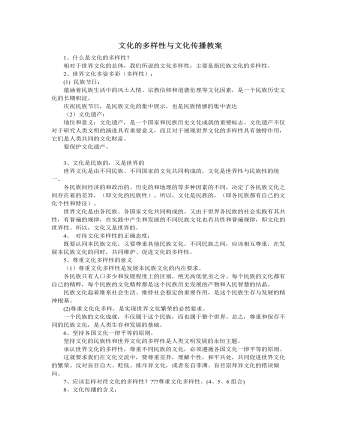
人教版高中政治必修3文化的多样性与文化传播教案
8、文化传播的含义:文化交流的过程,就是文化传播的过程。 人们通过一定的方式传递知识、信息、观念、情感和信仰,以及与此相关的所有社会交往活动,都可视为文化传播。9、文化传播的途径(1)商业活动。商人进行贸易活动时,不仅通过商品交换将商品中蕴涵的丰富文化加以交流,而且通过人与人之间的交往过程交流文化。(2)人口迁徙。每一次大规模的人口迁徙,都意味着大规模的文化传播,都会对当时当地的经济、政治、文化产生极大的影响。(3)教育教育是文化传播的又一重要途径。人们通过学习各种文化课程,能够获得不同的文化知识。文化传播是教育的重要功能。10、大众传媒:现代文化传播的手段现代社会中的传媒有报刊、广播、电视、网络等多种形式,这类传媒被称为大众传媒。依托现代信息技术,大众传媒能够最大程度地超越时空的局限,汇集来自世界各地的信息,日益显示出文化传递、沟通、共享的强大功能,已成为文化传播的主要手段。
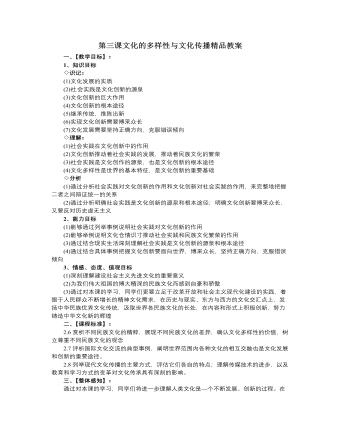
人教版高中政治必修3第三课文化的多样性与文化传播精品教案
◇探究提示:我们可以通过人际交往,阅读报纸、杂志、书籍等,欣赏电视、上网查询、发送手机短信、阅读电子读物等方式来搜集资料。其特点为:人际传播是社会生活中最直观、最常见、最丰富的传播现象,具有传播渠道多、方法灵活、意义丰富、反馈及时的特点。报纸、杂志、书籍等,可以通过扫描、编排处理后,显示在互联网上,供广大读者使用。电视提供了动态画面和缤纷的色彩,使人们对信息的理解变得更生动、形象和真实。互联网具有传播同网、全球同时、受众主动、双向互动的特点。手机短信用精练的语言传达丰富多彩的内容,不仅具有娱乐性,还具有情感性、艺术性耙哲理性,让人回味无穷。电子读物实现了文字、图像、声音的完关结合,使人在看图阅文的同时可以听音乐、写文章、做笔记、复制文件等等。

人教版高中政治必修3第四课文化的继承性与文化发展精品教案
◇探究提示:(1)孔子思想体系的核心是“仁’’和“礼”,其主要内容是“仁者爱人”和“克己复礼”。孔子提出“仁”的学说,要求统治者体察民情,反对苛政和任意刑杀;提倡广泛地理解、体贴他人,以此调整人际关系,稳定社会秩序。孔子讲的“克己复礼”,是说做人要克制自己,使自己的行为符合‘‘礼’’的要求。(2)老子认为“道”是凌驾于天之上的天地万物的本原,他提出‘‘天法道,道法自然”的思想。老子从“天道自然无为”的思想出发,倡导政治上“无为而治”,以“无事取天下”。老子哲学中包含着丰富的辩证法思想,他指出,任何事物都有矛盾、对立的两个方面,矛盾双方可以相互转化。(3)墨子主张“兼爱”“非攻”,“兼爱”就是无等差的爱,无论任何人,都不分轻重厚薄;“非攻”就是反对不义的兼并战争,主张各国和平相处。(4)韩非子崇尚法,强调法的重要性,主张法、术、势相结合,建立一个君主专制的中央集权国家,要求人人必须遵守法;韩非子还认为社会不断发展变化,历史永远不会倒退,主张变法革新。
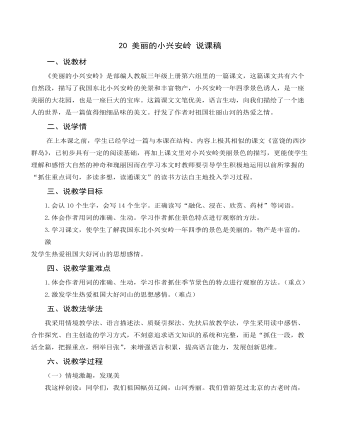
《美丽的小兴安岭》说课稿
教师先范读本段,学生边听边仔细观图,然后默读,划出作者抓住了春季的哪些景物,划出你认为作者用词准确、生动的句子,再说说这些词句好在哪里,最后指导学生边有感情地品读,边想象美景。再通过换词法理解了“抽出”的意思,通过结合实际理解了“散步”“欣赏”,体会了拟人句的作用。
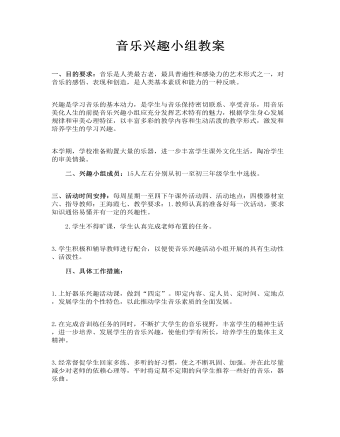
音乐兴趣小组教案
二、兴趣小组成员:15人左右分别从初一至初三年级学生中选拔。 三、活动时间安排:每周星期一至四下午课外活动四、活动地点:四楼器材室六、指导教师:王海霞七、教学要求:1.教师认真的准备好每一次活动,要求知识通俗易懂并有一定的兴趣性。 2.学生不得旷课,学生认真完成老师布置的任务。 3.学生积极和辅导教师进行配合,以便使音乐兴趣活动小组开展的具有生动性、活泼性。
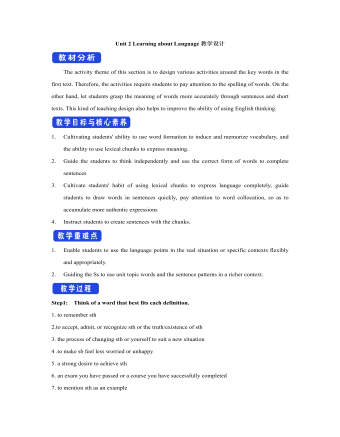
新人教版高中英语选修2Unit 2 Learning about Language教学设计
The activity theme of this section is to design various activities around the key words in the first text. Therefore, the activities require students to pay attention to the spelling of words. On the other hand, let students grasp the meaning of words more accurately through sentences and short texts. This kind of teaching design also helps to improve the ability of using English thinking.1. Cultivating students' ability to use word formation to induce and memorize vocabulary, and the ability to use lexical chunks to express meaning.2. Guide the students to think independently and use the correct form of words to complete sentences3. Cultivate students' habit of using lexical chunks to express language completely, guide students to draw words in sentences quickly, pay attention to word collocation, so as to accumulate more authentic expressions4. Instruct students to create sentences with the chunks.1. Enable students to use the language points in the real situation or specific contexts flexibly and appropriately.2. Guiding the Ss to use unit topic words and the sentence patterns in a richer context.Step1: Think of a word that best fits each definition.1. to remember sth2.to accept, admit, or recognize sth or the truth/existence of sth3. the process of changing sth or yourself to suit a new situation4 .to make sb feel less worried or unhappy5. a strong desire to achieve sth
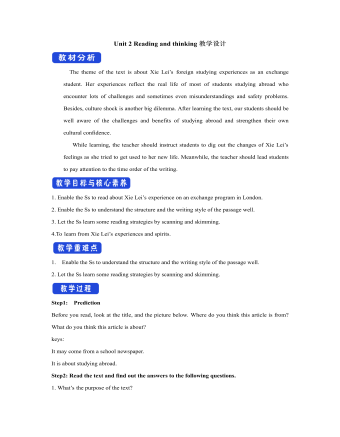
新人教版高中英语选修2Unit 2 Reading and thinking教学设计
Her tutor told her to acknowledge __________ other people had said if she cited their ideas, and advised her _______(read) lots of information in order to form __________wise opinion of her own.Now halfway __________ her exchange year, Xie Lei felt much more at home in the UK. She said __________ (engage) in British culture had helped and that she had been__________ (involve) in social activities. She also said while learning about business, she was acting as a cultural messenger __________(build) a bridge between the two countries. keys:Xie Lei, a 19yearold Chinese student, said goodbye to her family and friends in China and boarded (board) a plane for London six months ago in order to get a business qualification. She was ambitious(ambition) to set up a business after graduation. It was the first time that she had left (leave) home.At first, Xie Lei had to adapt to life in a different country. She chose to live with a host family, who can help with her adaptation (adapt) to the new culture. When she missed home, she felt comforted (comfort) to have a second family. Also Xie Lei had to satisfy academic requirements. Her tutor told her to acknowledge what other people had said if she cited their ideas, and advised her to read lots of information in order to form a wise opinion of her own.Now halfway through her exchange year, Xie Lei felt much more at home in the UK. She said engaging (engage) in British culture had helped and that she had been involved (involve) in social activities. She also said while learning about business, she was acting as a cultural messenger building a bridge between the two countries.
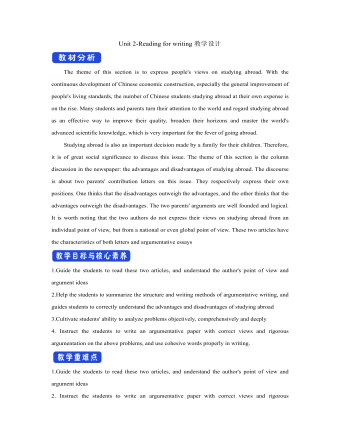
新人教版高中英语选修2Unit 2 Reading for writing教学设计
The theme of this section is to express people's views on studying abroad. With the continuous development of Chinese economic construction, especially the general improvement of people's living standards, the number of Chinese students studying abroad at their own expense is on the rise. Many students and parents turn their attention to the world and regard studying abroad as an effective way to improve their quality, broaden their horizons and master the world's advanced scientific knowledge, which is very important for the fever of going abroad. Studying abroad is also an important decision made by a family for their children. Therefore, it is of great social significance to discuss this issue. The theme of this section is the column discussion in the newspaper: the advantages and disadvantages of studying abroad. The discourse is about two parents' contribution letters on this issue. They respectively express their own positions. One thinks that the disadvantages outweigh the advantages, and the other thinks that the advantages outweigh the disadvantages. The two parents' arguments are well founded and logical. It is worth noting that the two authors do not express their views on studying abroad from an individual point of view, but from a national or even global point of view. These two articles have the characteristics of both letters and argumentative essays1.Guide the students to read these two articles, and understand the author's point of view and argument ideas2.Help the students to summarize the structure and writing methods of argumentative writing, and guides students to correctly understand the advantages and disadvantages of studying abroad3.Cultivate students' ability to analyze problems objectively, comprehensively and deeply

新人教版高中英语选修2Unit 3 Using langauge-Listening教学设计
1. How is Hunan cuisine somewhat different from Sichuan cuisine?The heat in Sichuan cuisine comes from chilies and Sichuan peppercorns. Human cuisine is often hotter and the heat comes from just chilies.2.What are the reasons why Hunan people like spicy food?Because they are a bold people. But many Chinese people think that hot food helps them overcome the effects of rainy or wet weather.3.Why do so many people love steamed fish head covered with chilies?People love it because the meat is quite tender and there are very few small bones.4.Why does Tingting recommend bridge tofu instead of dry pot duck with golden buns?Because bridge tofu has a lighter taste.5 .Why is red braised pork the most famous dish?Because Chairman Mao was from Hunan, and this was his favorite food.Step 5: Instruct students to make a short presentation to the class about your choice. Use the example and useful phrases below to help them.? In groups of three, discuss what types of restaurant you would like to take a foreign visitor to, and why. Then take turns role-playing taking your foreign guest to the restaurant you have chosen. One of you should act as the foreign guest, one as the Chinese host, and one as the waiter or waitress. You may start like this:? EXAMPLE? A: I really love spicy food, so what dish would you recommend?? B: I suggest Mapo tofu.? A: Really ? what's that?

新人教版高中英语选修2Unit 4 Learning about Language教学设计
This section guides students to pay attention to the typical context of vocabulary use, helps students accumulate vocabulary around the key vocabulary of this unit, and uses the learned words and word chunks in different contexts to deeply understand their meaning and usage, so as to achieve the purpose of review and consolidation.The teaching design activities aim to guide students to pay attention to the typical context in which the target vocabulary is used, as well as the common vocabulary used in collocation, so that students can complete the sentence with correct words. In terms of vocabulary learning strategies, this unit focuses on cultivating students' ability to pay attention to collocation of words and to use word blocks to express meaning.For vocabulary learning, it is not enough just to know the meaning of a single word, but the most important thing is to master the common collocations of words, namely word blocks.Teachers should timely guide students to summarize common vocabulary collocation, such as verb and noun collocation, verb and preposition collocation, preposition and noun collocation, and so on.1. Guide students to understand and consolidate the meaning and usage of the vocabulary in the context, 2. Guide the students to use the unit topic vocabulary in a richer context3. Let the students sort out and accumulate the accumulated vocabulary, establishes the semantic connection between the vocabulary,4. Enable students to understand and master the vocabulary more effectivelyGuiding the Ss to use unit topic words and the sentence patterns in a richer context.

新人教版高中英语选修2Unit 4 Using langauge-Listening教学设计
The theme of the listening section is " talking about scenery and culture along a journey."The part is designed to further lead the students to understand Canadian natural geography and social environment, and integrated into the cultural contrast by mentioning the long train journey from Beijing to Moscow routes. On this basis, the part activates students related travel experience, lets the student serial dialogue, guides the student to explore further the pleasure and meaning of the long journey, and Chinese and foreign cultural comparison.The part also provides a framework for the continuation of the dialogue, which is designed to provide a framework for students to successfully complete their oral expressions, and to incorporate an important trading strategy to end the dialogue naturally.1. Help students to understand and master some common English idioms in the context, and experience the expression effect of English idioms.2. Guide the students to understand the identity of different people in the listening context, and finish the dialogue according to their own experience.3. Instruct the students to use appropriate language to express surprise and curiosity about space and place in the dialogue, and master the oral strategy of ending the dialogue naturally.1. Instruct students to grasp the key information and important details of the dialogue.2. Instruct students to conduct a similar talk on the relevant topic.

新人教版高中英语选修2Unit 5 Learning about Language教学设计
The purpose of this section of vocabulary exercises is to consolidate the key words in the first part of the reading text, let the students write the words according to the English definition, and focus on the detection of the meaning and spelling of the new words. The teaching design includes use English definition to explain words, which is conducive to improving students' interest in vocabulary learning, cultivating their sense of English language and thinking in English, and making students willing to use this method to better grasp the meaning of words, expand their vocabulary, and improve their ability of vocabulary application. Besides, the design offers more context including sentences and short passage for students to practice words flexibly.1. Guide students to understand and consolidate the meaning and usage of the vocabulary in the context, 2. Guide the students to use the unit topic vocabulary in a richer context3. Let the students sort out and accumulate the accumulated vocabulary, establishes the semantic connection between the vocabulary,4. Enable students to understand and master the vocabulary more effectivelyGuiding the Ss to use unit topic words and the sentence patterns in a richer context.Step1: Read the passage about chemical burns and fill in the blanks with the correct forms of the words in the box.

新人教版高中英语选修2Unit 5 Using langauge-Listening教学设计
The theme of this section is to learn how to make emergency calls. Students should learn how to make emergency calls not only in China, but also in foreign countries in English, so that they can be prepared for future situations outside the home.The emergency telephone number is a vital hotline, which should be the most clear, rapid and effective communication with the acute operator.This section helps students to understand the emergency calls in some countries and the precautions for making emergency calls. Through the study of this section, students can accumulate common expressions and sentence patterns in this context. 1.Help students accumulate emergency telephone numbers in different countries and learn more about first aid2.Guide the students to understand the contents and instructions of the telephone, grasp the characteristics of the emergency telephone and the requirements of the emergency telephone.3.Guide students to understand the first aid instructions of the operators.4.Enable Ss to make simulated emergency calls with their partners in the language they have learned1. Instruct students to grasp the key information and important details of the dialogue.2. Instruct students to conduct a similar talk on the relevant topic.Step1:Look and discuss:Match the pictures below to the medical emergencies, and then discuss the questions in groups.